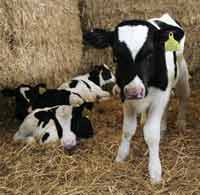Rose veal scheme opens up dairy calf opportunities

Opportunities for rearing and finishing black and white calves from the dairy herd could open up for producers on the UK mainland, if a rose veal project which began in Ireland continues its expansion.
Linden Foods managing director, Gerry Maguire told delegates at an English Farming and Food Partnerships conference in Newcastle (18 March) that several farms in Ireland were currently participating in the rose veal scheme. The product was marketed under the brand name, Banquet Royale Rose Veal.
The first rose veal calves were slaughtered in July 2007, he said. By this September, the company expected to be marketing around 180 calves per week. The high welfare system allowed Holstein bull calves to be reared on specialist units, rather than being exported to white veal systems across Europe, said Mr Maguire.
One of the main outlets was Sweden, where there was a high level of consumer demand, and home-produced veal was very expensive.
The Dungannon-based Linden Foods, which owned abattoirs in Whitley Bay and Gateshead in the north-east, initially developed the rose veal scheme to increase abattoir throughput efficiency. It was also designed to make up for a predicted beef cattle shortfall of 12-15%, due to an overall reduction in suckler cow numbers.
Mr Maguire said that the Linden Livestock rose veal scheme operated in a similar way to bed and breakfast pig rearing. His company supplied the calf, and covered all feed and vet bills during the 12-week ‘nursery’ period. The calf would subsequently be sent to a finishing unit, to be slaughtered at an average weight of 205kg at 9-10 months old. Linden Livestock also supplied a computerised record-keeping program, which was linked to a central database.
Getting involved
Mr Maguire stressed that producers wishing to get involved in rose veal production would have to conform to strict management standards. Existing members had been hand-picked for their high level of stockmanship.
Nursery rearers would also be asked to invest around £28,000 in purpose-built housing that adhered to a design template drawn up by Linden Foods. The calves would be housed in groups on straw, and fed a milk and cereal-based diet.
Returns to scheme members were performance linked, but average profitability for the nursery rearer was around £35/head, he said. Producers who did not want to commit to investing in the nursery building, could get involved in the finishing element of the scheme, he added.
On the finishing units, calves are fed a special concentrate ration, plus straw, until slaughter. The feed is forward-purchased, and the calf is bought from Linden Livestock at a fixed price. Average meal consumption is roughly 1.6t a head. A contract price for the finished calf is set at between £2.50/kg and £2.60/kg, which leaves the farmer with a margin of about £80 to £100 a head.
Benefits for producers
Joining the scheme could allow a producer’s wife, son or daughter, to stay at home and contribute to farm income, said Mr Maguire. “We have already discussed the idea with a group of English producers, and have had a very positive response. However scheme member numbers will be restricted, until the market is further developed.
“Feedback suggests that the concept has merits for livestock producers, because it removes risk and has good cash flow potential. We would like to have a few units set up in the north-east region by the end of the year.”
Case study: Lilburn Estates
Farm manager, Ray Field said even large farms and estates would struggle to brand their meat for marketing direct to the customer, because of the practical difficulties of all year round supply. He manages the 12,500ha Lilburn Estates in Northumberland, which produces around 1,100 finished cattle and 12,000 lambs annually.
Mr Field’s preferred policy was to monitor returns from a number of different outlets on a weekly basis.
“If you collect price information regularly, a pattern will emerge, identifying the companies that are paying the best prices. The same applies to killing out percentages for stock sold deadweight. Our aim is also to minimise the payment of agent commissions wherever possible, so we can retain an extra few pence per kg for ourselves.”
Establishing relationships along the supply chain would not help farmers, unless it resulted in premium farm gate prices, he warned. But he had been encouraged by enquiries from buyers keen to source lambs from the Estate in recent months – probably because there had been talk of shortages, coupled with concerns over Bluetongue.
Another relatively recent development at Lilburn had been to move towards a closed herd and a closed flock, he explained. Most of the livestock on the farm were home-bred, apart from a few tups and stock bulls. The ultimate goal was to gain accreditation for being free of a number of common diseases – particularly in cattle – that would reduce productivity and restrict potential markets, he added.
*The conference sponsors included the NFU, One NorthEast and the North East England Food and Drink Group.
